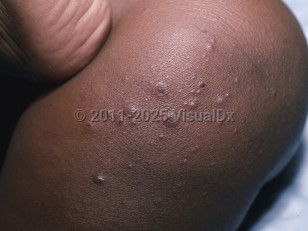The echoviruses are members of the genus Enterovirus and are responsible for many varied clinical syndromes in humans. The most common clinical presentation is an undifferentiated febrile illness.
Echoviruses can cause an upper respiratory infection. Symptoms may include sore throat, coryza, and cough. Some echoviruses can cause severe lower respiratory tract disease in infants.
Echoviruses are frequently associated with rashes. Hand-foot-and-mouth disease can be caused by certain echovirus serotypes (this syndrome is more commonly caused by other enteroviruses). This disease is most common in children. Patients have sore throat and fever. Vesicles are present in the oral cavity. Vesicular and papular lesions are also seen on the extensor surfaces of the hands and feet.
Herpangina is another clinical syndrome that has been associated with the echoviruses (although is more commonly caused by coxsackieviruses). Patients frequently have fever, sore throat, and headache. This is followed over the course of hours to days by an eruption on the soft palate, uvula, and tonsils. The eruption begins as macules that progress to papules and then to vesicles.
Echoviruses can result in a variety of neurological manifestations, including acute viral meningitis. Patients present acutely or subacutely with headache. Fever, chills, and meningismus may or may not be present. Encephalitis due to echoviruses has also been reported. Symptoms may be mild or severe and be associated with seizures or coma. There has been an association made between echoviruses and Guillain-Barré syndrome.
Echoviruses can cause pleurodynia (an acute infection of skeletal muscle). Patients have fever and sharp pain in the chest and upper abdomen. Certain serotypes can also cause myopericarditis.
Echoviruses have also been associated with diarrhea in infants.
Diagnosis is made by viral culture or by isolating viral RNA by nucleic acid testing. No specific antiviral therapy is available.
Echovirus infection in Adult
Alerts and Notices
Important News & Links
Synopsis

Codes
ICD10CM:
B97.12 – Echovirus as the cause of diseases classified elsewhere
SNOMEDCT:
271532008 – Echovirus disease
B97.12 – Echovirus as the cause of diseases classified elsewhere
SNOMEDCT:
271532008 – Echovirus disease
Differential Diagnosis & Pitfalls

To perform a comparison, select diagnoses from the classic differential
Subscription Required
Best Tests
Subscription Required
References
Subscription Required
Last Updated:09/04/2023

